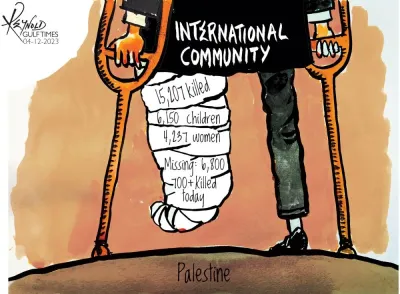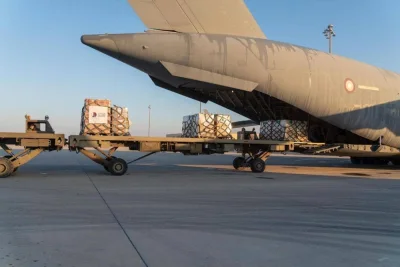- Palestinian officials say 109 people killed since truce expired
- Aid trucks stuck on Egypt’s border with Gaza
Israel’s warplanes pounded Gaza on Friday after talks to extend a week-old truce with Hamas broke down, sending wounded and dead Palestinians into hospitals and others onto the streets to seek safety.
Eastern areas of Khan Younis in southern Gaza came under intensive bombardment as the deadline lapsed shortly after dawn, with columns of smoke rising into the sky, Reuters journalists in the city said. Residents took to the road with belongings heaped up in carts, fleeing for shelter further west.
In the north of the enclave, previously the main war zone, huge plumes of smoke rose above the ruins, seen from across the fence in Israel. The rattle of gunfire and thud of explosions rang out above the sound of barking dogs.
Rocket sirens also blared across southern Israel as militants fired from the coastal enclave into towns.
Within hours of the truce expiring, Gaza health officials reported that 109 people had been killed and dozens wounded in air strikes that hit at least eight homes.
Medics and witnesses said the bombing was most intense in Khan Younis and Rafah in the southern Gaza Strip, where hundreds of thousands of Gazans have been sheltering from fighting further north. Houses in central and northern areas were also hit.
“Anas, my son!” wailed the mother of Anas Anwar al-Masri, a boy lying on a stretcher with a head injury in the corridor of Nasser hospital in Khan Younis. “I don’t have anyone but you!”
Further south in Rafah, residents carried several small children, streaked with blood and covered in dust, out of a house that had been struck. Mohammed Abu-Elneen, whose father owns the house, said it was sheltering people displaced from elsewhere.
At the nearby Abu Yousef al-Najjar hospital, the first wave of wounded were men and boys.
Gazans said they feared that the bombing of southern parts of the enclave could herald an expansion of the war into areas Israel had previously described as safe.
Leaflets dropped on eastern areas of the main southern city Khan Younis ordered residents of four towns to evacuate – not to other areas in Khan Younis as in the past, but further south to the crowded town of Rafah on the Egyptian border.
“You have to evacuate immediately and go to the shelters in the Rafah area. Khan Younis is a dangerous fighting zone. You have been warned,” said the leaflets, written in Arabic.
Israel released a link to a map showing Gaza divided into hundreds of districts, which it said would be used in future to communicate which areas were safe.
The United Nations said the collapse of the ceasefire would worsen an extreme humanitarian emergency.
“Hell on Earth has returned to Gaza,” said Jens Laerke, spokesperson for the UN humanitarian office in Geneva.
There were expressions of regret and dismay from leaders around the world, though notable silence, at least initially, from Washington, with US Secretary of State Antony Blinken, on a trip to the region, declining to answer questions about it to reporters on his plane.
Each of the warring sides blamed the other for causing the collapse by rejecting terms to extend the daily release of hostages held by militants in exchange for Palestinian detainees.
The pause which began on November 24 had been extended twice, and Israel had said it could continue as long as Hamas released 10 hostages each day. But after seven days during which women, children and foreign hostages were freed, mediators failed at the final hour to find a formula to release more, including Israeli soldiers and civilian men.
Israel accused Hamas of refusing to release all the women it held. A Palestinian official said the breakdown occurred over female Israeli soldiers.
Qatar, which has played a central role in mediation efforts, said negotiations were still ongoing with Israelis and Palestinians to restore the truce, but that Israel’s renewed bombardment of Gaza had complicated its efforts.
Israel’s bombardment and ground invasion have laid waste to much of the territory. Palestinian health authorities deemed reliable by the United Nations say more than 15,000 Gazans have been confirmed killed and thousands more are missing and feared buried under rubble.
The United Nations says as many as 80% of Gaza’s 2.3 million have been driven from their homes, with no way to escape the narrow territory, many sleeping rough in makeshift shelters.
Israel has imposed a total siege, and residents and humanitarian agencies say aid that arrived during the truce was trivial compared to the vast needs of so many displaced people.
Drivers at the crossing from Egypt said the resumption of fighting had halted the movement into Gaza of aid trucks, which go through a laborious process of Israeli inspections that had sped up during the truce.
“The bombardment has been going on since seven in the morning. There are planes and artillery and we haven’t moved,” said driver Saleh Ebada, who had already been waiting to enter the crossing for inspection for eight days.
Washington has said publicly that it was putting pressure on its ally Israel to better protect civilians once war resumed. Blinken, who had met Israeli and Palestinian officials on Thursday on his third trip to the region since the war began, had praised the truce and said Washington hoped it would be extended.
 Kokani.me Kokani.me
Kokani.me Kokani.me



